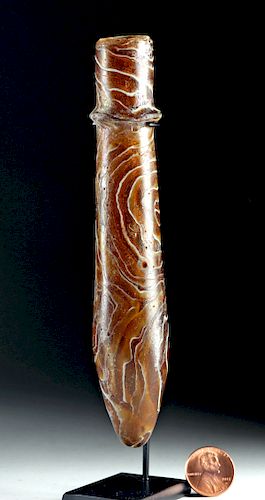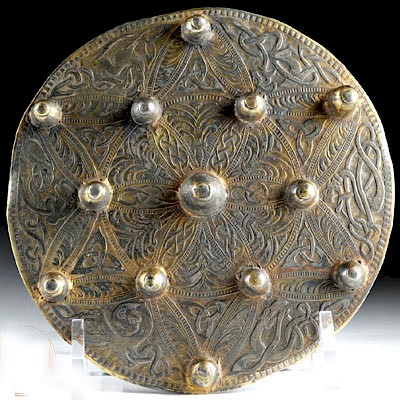Late Hellenistic / Early Roman Glass Mosaic Alabastron
Lot 25
About Seller
Artemis Fine Arts
686 S Taylor Ave, Ste 106
Louisville, CO 80027
United States
Selling antiquities, ancient and ethnographic art online since 1993, Artemis Gallery specializes in Classical Antiquities (Egyptian, Greek, Roman, Near Eastern), Asian, Pre-Columbian, African / Tribal / Oceanographic art. Our extensive inventory includes pottery, stone, metal, wood, glass and textil...Read more
Estimate:
$2,500 - $3,500
Absentee vs Live bid
Two ways to bid:
- Leave a max absentee bid and the platform will bid on your behalf up to your maximum bid during the live auction.
- Bid live during the auction and your bids will be submitted real-time to the auctioneer.
Bid Increments
| Price | Bid Increment |
|---|---|
| $0 | $25 |
| $300 | $50 |
| $1,000 | $100 |
| $2,000 | $250 |
| $5,000 | $500 |
| $10,000 | $1,000 |
| $20,000 | $2,500 |
| $50,000 | $5,000 |
| $100,000 | $10,000 |
| $200,000 | $20,000 |
About Auction
By Artemis Fine Arts
Jul 19, 2018
Set Reminder
2018-07-19 10:00:00
2018-07-19 10:00:00
America/New_York
Bidsquare
Bidsquare : Fine Antiquities/Ethnographic Art
https://www.bidsquare.com/auctions/artemis-gallery/fine-antiquities-ethnographic-art-3329
Featuring classical antiquities, ancient and ethnographic art from cultures encompassing the globe, plus fine art. Artemis Fine Arts info@artemisgallery.com
Featuring classical antiquities, ancient and ethnographic art from cultures encompassing the globe, plus fine art. Artemis Fine Arts info@artemisgallery.com
- Lot Description
Late Hellenistic / Early Roman Imperial Period, ca. 1st century BCE to 1st century CE. A stunning translucent alabastron formed with amber-hued glass with multiple strands of opaque white glass. The alabastron, likely used to contain perfumes and other scented oils, has an elongated cylindrical form with a conical base, a thick unpronounced rim, and a raised discoid guard which delineates the neck. Its elegant presentation and opulent color suggest this vessel was used by a woman of high status, meant to be taken to the bath houses and used as part of their toiletries. Covered in faint layers of rainbow-hued iridescence, this is a marvelous work of glass art to be treasured for its impeccable form, beautiful hues, and sophisticated technique. Custom museum-quality display stand included. Size: 1" W x 5.75" H (2.5 cm x 14.6 cm); 6.75" H (17.1 cm) on included custom stand.
The alabastron is a long-bodied vessel, typically with a rounded bottom, a cylindrical neck, and a flat disk for a mouth. Though usually without handles, some alabastra have eyes, lugs, or disc-shaped guards like this example. According to the Beazley Archive of the University of Oxford, the alabastron shape's history extends back to Corinth, but was only preserved in Athenian pottery examples back to the mid-sixth century BCE. Alabastra were created in many materials, including alabaster, and the Greek term for this stone - alabastron (most likely of Egyptian origin) - was the source of inspiration for the name of this shaped vessel. Many examples were finished with a white ground, as if to imitate this stone. We know from vase painting imagery of women using alabastra following a bath, that these vessels most likely held perfumed oils.
For a Hellenistic example exhibiting the same style of mosaic glass, please see The Metropolitan Museum of Art, accession number 91.1.1303: https://www.metmuseum.org/art/collection/search/245691
For an example of the same mosaic glass style from the early Roman Imperial period, please see The Metropolitan Museum of Art, accession number 91.1.1643: https://www.metmuseum.org/art/collection/search/256995
Provenance: private New York, USA collection
All items legal to buy/sell under U.S. Statute covering cultural patrimony Code 2600, CHAPTER 14, and are guaranteed to be as described or your money back.
A Certificate of Authenticity will accompany all winning bids.
We ship worldwide and handle all shipping in-house for your convenience.
#134582Spout above discoid guard repaired from a few large pieces with light adhesive residue along break lines. Surface wear and abrasions commensurate with age, some minor pitting holes, and light roughness across most surfaces. Light earthen deposits and scattered areas of nice rainbow iridescence throughout.Condition
- Shipping Info
-
All shipping is handled in-house for your convenience. Your invoice from Artemis Gallery will include shipping calculation instructions. If in doubt, please inquire BEFORE bidding for estimated shipping costs for individual items.
-
- Buyer's Premium



 EUR
EUR CAD
CAD AUD
AUD GBP
GBP MXN
MXN HKD
HKD CNY
CNY MYR
MYR SEK
SEK SGD
SGD CHF
CHF THB
THB














